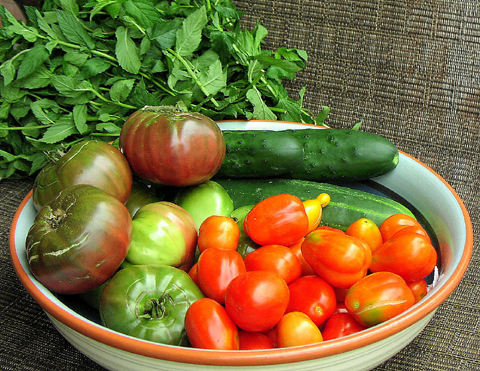
SALADOLOGY

Saladology is the science of salads. Like atoms in chemistry, salads are viewed as consisting of two different parts: the main solid constituents, such as lettuce or tomato (like the protons and neutrons in the nucleus), with a fluid or fluid-like surround- the dressing (like the electronic shells). The nature of the main solid constituents determines what kind of dressing is needed to balance the whole, just as the number of protons determines the number and kind of electronic shells surrounding the atomic nucleus.
The dressing is not entirely fluid. It usually contains a member of the onion family, and there is always a herb- a different herb for each of the main salad types, depending on the main constituent; and they all contain salt and pepper
Here are some examples of classified salads.
Classic French Salad Main constituent: lettuce (often two kinds- flat-leaved and frisée) Onion family: garlic, finely chopped Herb: Tarragon Dressing: olive oil and red wine vinegar.
Classic German Salad (which, alas, most Germans have forgotten) Main constituent: Lettuce Onion family: chives, finely chopped Herb: fresh Borage Dressing: sunflower oil and a little organic malt vinegar (NB Must be organic now, for most “malt” vinegar is synthetic coloured acetic acid)
Tomato Salad Main constituent: tomato Onion family: garlic, finely chopped Herb: fresh Basil Dressing: olive oil, and a little red wine vinegar (optional)
Cucumber Salad Main constituent: cucumber, sliced see-through thin Onion family: chives, finely chopped Herb: Dill Dressing: sunflower oil, sour cream and a little organic malt vinegar
Raw Carrot Salad (Summer) Main constituent: carrots, grated in thin slivers Onion family: garlic, finely chopped Herb: parsley Dressing: olive oil and lemon juice
Raw Carrot Salad (Autumn) Main constituents: carrots, finely grated to a juicy mush, together with celery (preferably English, after the first frost), cut into short pieces, dressed as above.
Cooked Chard Salad Main constituent: chard. The green leafy part is cut from the stems, which are cut into small pieces and cooked in salt water until tender, when the green leaves are added and cooked a little longer, and the whole mass is drained, but the liquid is kept. Onion family: garlic, cloves cut into two or three, removed when eating Herb: None Dressing: olive oil and lemon juice This salad is best served slightly warm, and should be sloppy- add a little of the retained fluid if it is not.
Cooked Runner Bean Salad Main constituent: top, tail and string the runner beans, then cut into thin slices at a sharp angle to the length of the beans to give pieces about ¾ inch long, and cook until tender, drain, and keep the liquid Onion family: onion, finely chopped, gently cooked in sunflower oil until soft Herb: Summer or Winter Savory Dressing: sunflower oil and (a little) organic malt vinegar Note: like the chard salad, delicious slightly warm (though also good when cold) and should also be a bit sloppy- add back some the drained liquid if needed.
An octave of salads, each with a different herb (in one case, no herb) to harmonise with the main constituent(s).
Tilo Ulbricht